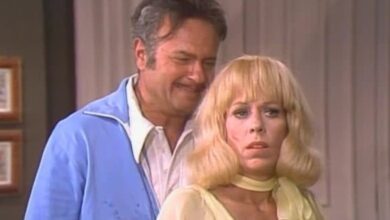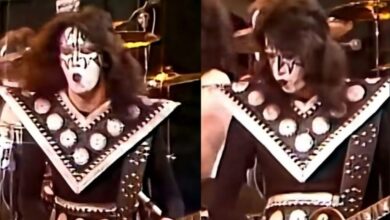Miranda Lambert and Chris Stapleton Deliver a Timeless, Dolly-and-Kenny-Style Duet with “A Song To Sing” at the CMA Awards 2025
The 59th CMA Awards on November 19, 2025, had plenty of high-energy moments, but when Miranda Lambert and Chris Stapleton walked out to perform “A Song To Sing,” the room shifted into a different gear. It felt like the show briefly stepped out of the modern spotlight and into something more timeless. The arena wasn’t roaring the way it did for the bigger bangers earlier in the night; instead, it hushed in that rare way people do when they sense they’re about to witness something that lives beyond the broadcast.
What made the performance immediately striking was how deliberately it leaned into classic duet tradition. “A Song To Sing” is their first recorded duet together, and you could feel that “we’ve waited for this” energy in the way they approached it. Instead of trying to reinvent the wheel, they framed the song like a love letter to country’s golden era, especially the effortless magic Dolly Parton and Kenny Rogers used to bring when they sang side by side.
The staging carried that throwback spirit without turning into a costume party. The lights warmed into soft amber tones, and the set felt intimate, almost like a late-night television special from decades ago. There was a gentle retro shimmer in the visual mood, but nothing flashy enough to pull focus from the voices. The show let the song breathe, and that choice paid off, because this duet lives on emotional chemistry more than spectacle.
Miranda’s entrance into the first verse felt like she was gliding straight into her sweet spot: tender, controlled, and quietly strong. She didn’t oversing it or push for power just because it was the CMAs. Her phrasing stayed relaxed, letting the lyric do the work. What you heard was the kind of vocal balance that made her famous early on — the ability to sound soft without ever sounding small.
Stapleton’s presence beside her was the perfect counterweight. His voice came in with that smoky grit that always feels like it’s wrapped in honest wear and tear, even when he’s singing a love song. On this track, he didn’t dominate the space; he grounded it. Every line he delivered felt like a slow, steady pulse under Miranda’s melody, giving the duet that “two people in the same story” feel instead of a call-and-response gimmick.
Musically, the performance leaned into the song’s disco-tinged country groove, but in a tasteful way. The rhythm had a subtle bounce, the kind you feel in your shoulders more than in your feet, and the band kept it smooth rather than loud. That groove is part of what makes “A Song To Sing” feel like a bridge between eras — country storytelling on top, soft 70s shimmer underneath, and no apology for either one.
The chemistry between them was understated, and that’s exactly why it worked. They weren’t acting out romance for the cameras. They were simply standing close enough to share the same emotional temperature. You could catch small glances, a slight smile here and there, and the kind of calm confidence that comes from artists who trust the song and trust each other to hold the moment.
For fans who already knew the studio version, the CMA performance felt warmer and more lived-in. Live, the lyric landed with extra weight, especially in the chorus where both voices lock together. The blend didn’t sound polished into perfection; it sounded like two real voices meeting in the middle. That human edge made the performance feel bigger than the stage size, even though nothing about it was oversized.
There’s a nice bit of history behind why this duet feels so right. Lambert and Stapleton have written together before and have shared stages over the years, but they sat on “A Song To Sing” for a long time before finally recording it. That long simmer shows up in the way the song is built — it’s not chasing a trend, it’s settling into a sound that feels inevitable for them.
The Dolly-and-Kenny influence isn’t a vague marketing line either; it’s truly baked into the song’s design. The melody moves like a classic two-person conversation, and the lyric is simple without being shallow. It’s about connection, loyalty, and that “we’re in this together” feeling that old duet classics knew how to deliver without overexplaining themselves.
Their production choice also matters here. The recorded track was cut with Dave Cobb, a producer known for keeping artists close to their roots and letting performances stay organic. That same Cobb-style atmosphere carried into the CMA staging: no clutter, no overproduction, just the confidence that if the song is good and the voices are real, the room will come with you.
Part of the audience reaction came from how unexpected the vibe was for an awards show slot. The CMAs can be bright, fast, and engineered for replay, but this performance was more about atmosphere. It didn’t beg for applause every ten seconds. It just rolled forward smoothly, inviting the arena to lean in. You could feel people listening like they were inside the song, not outside watching it.
The song’s 70s flavor has been a talking point since its release, and the CMAs quietly amplified it. The live arrangement leaned into that retro sparkle — not enough to turn it into a novelty, but enough to make the nod clear. It felt like the kind of sound country can borrow from its own past without losing its identity, especially when artists as rooted as these two are guiding the blend.
In the wider context of the night, the duet also served as a reminder of what classic country performance still looks like in 2025. We got plenty of genre-stretching moments across the show, but “A Song To Sing” planted a flag for romance, harmony, and emotional simplicity. Not simple because it lacked depth, but simple because it trusted the audience to feel what was already there.
Even the post-performance chatter had a different tone than typical CMA buzz. Instead of people debating staging tricks or surprise guests, most reactions centered on the feeling: how natural it was, how beautifully their voices fit, how the throwback spirit didn’t feel forced. That’s a hard thing to pull off on a live TV stage, and they did it without breaking a sweat.
The medley-style openers and big awards moments will get their usual headlines, but this duet felt like one of those performances that grows in memory. Years from now, fans won’t just remember that Miranda Lambert and Chris Stapleton debuted their recorded duet at the CMAs. They’ll remember how it felt: like a warm time-machine moment where modern country tilted its hat to the past and proved it still knows how to make a room go quiet.
Sources (not shown in paragraphs, per your preference): AP and Washington Post recaps for show context, plus performance and song background from American Songwriter, iHeart/K102, and CMA official uploads.





